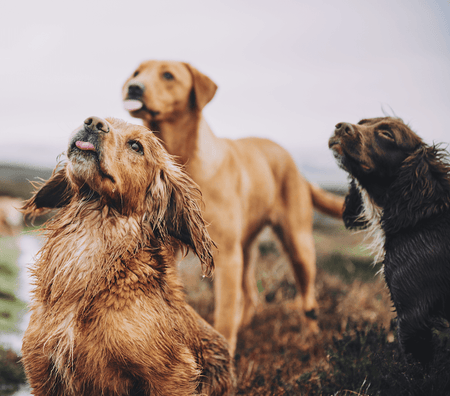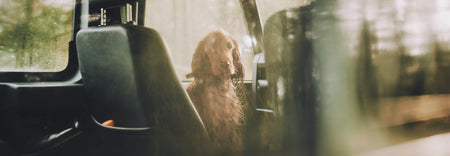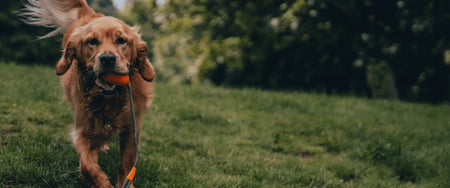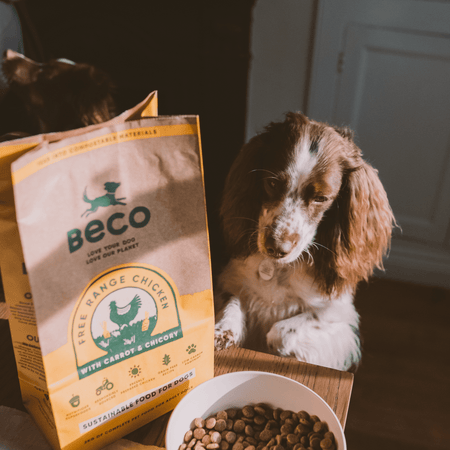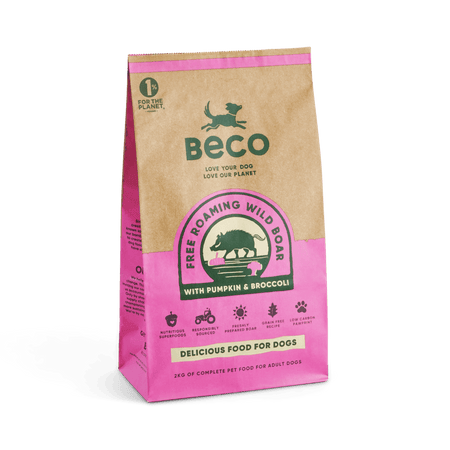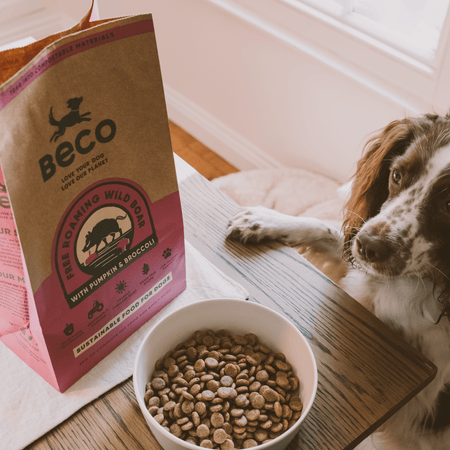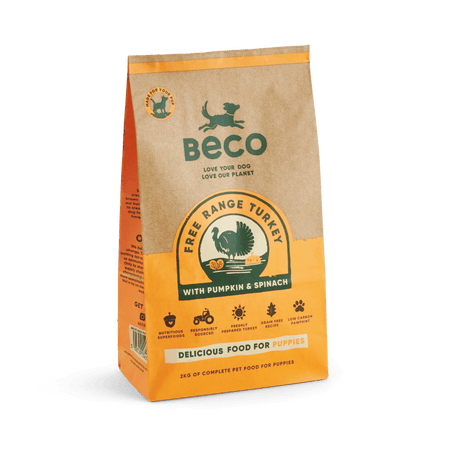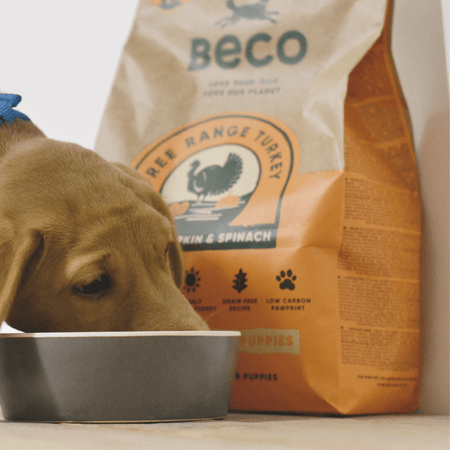As dog owners, we want to do what is best for our furry friends. This includes nailing their nutrition and walking them at the right time.
According to vets, there is a clear answer to this particular question. They advise that you should wait at least two hours after your dog has eaten a meal before walking them.
That’s because walking your dog straight after a meal can cause your dog to bloat, or even lead to gastric dilatation-volvulus (GDV).
You should also make sure water is always available to your dog to avoid them drinking excessive amounts of liquid on top of their food. When dogs gulp water they ingest large amounts of air, which can add to the risk of GDV occurring. GDV is a dangerous condition that requires immediate attention from a vet.
Read on to find out all about GDV, the best times to feed and walk your dogs, and whether exercising your dog on an empty stomach is a good idea.

Why You Should Wait to Walk Your Dog After Eating?
The main reason to avoid walking your dog straight after eating is because of the risk of bloating and GDV.
The same risks apply to other activities that might happen straight after a meal. After they’ve eaten a bowl of food, for example, you should try to stop your dog from playing or running around the garden or house.
What is Bloating in Dogs?
As in humans, bloating is an accumulation of gas in a dog’s stomach. GDV occurs when the stomach, filled with this trapped air, is rotated when the dog makes sharp movements during exercise or play.
The eight signs of GDV in dogs include:
- Drooling
- Restlessness
- Panting
- Retching
- Pacing
- Whining
- Rear checking
- Hard and distended abdomen
As a condition, GDV isn’t well-known, but it can be potentially fatal. If you spot any of the symptoms of GDV in your dog, seek help from a vet immediately. GDV develops without warning and can progress quickly. It is always an emergency.
Breeds at the Biggest Risk of GDV
While all dogs can bloat or develop GDV, those at the biggest risk are bigger breeds and deep chested breeds, such as:
Greyhounds
German Shepherds
Great Danes
Irish Setters
If your dog is having tummy or digestive troubles (which a qualified vet has confirmed is unrelated to GDV), then you may want to find out more about the right foods to feed dogs with sensitive stomachs.
Other Risks of Walking a Dog After Eating
Other risks associated with feeding your dog and going on a walk (or playing with them) immediately after a meal include:
Inhibiting circulation within the digestive tract
Interrupting proper food digestion
Vomiting
Abdominal pain and discomfort
Cramps
How Long Does it Take for a Dog to Digest Food?

How long a dog takes to digest food depends entirely on the breed, activity levels, and the type of food you’ve fed it. As a general rule, however, it usually takes 6 – 10 hours. Wet food takes less time to digest than dry food and can take as little as 4 hours for a dog’s body to break down.
So, How Long After Eating Should I Exercise My Dog?
As a rule of thumb, if you’re thinking of walking a dog after eating, vets advise waiting at least two hours if possible.
There are, however, some exceptions to this rule. The time you should wait between your dog having eaten food and taking them for a walk depends on the amount of food consumed and speed of his digestive system. The best thing to do is to follow this general rule:
At least 30 minutes after a small snack
1 hour after a small meal
2 to 3 hours after a medium/large meal
It’s important to remember that, aside from the risks of GDV, walking is good for digestion in dogs. It helps keep their poop regular and healthy and can help manage common digestive issues, such as doggy constipation.
When is the Best Time to Feed My Dog?
Mature dogs need to be fed two times a day, usually morning and evening. Between four and six months old, puppies need three meals per day. For a fully grown dog, you should typically wait anywhere from four to six hours between feeds. This gap allows your dog to properly digest previous meals before they eat again.
How Often Should I Walk My Dog?
You should be walking your dog at least twice a day. This could be split into 20 or 30 minutes of walking in the morning and in the evening.
There are a number of factors that affect your walk length and schedule. These include the dog’s breed and size, age and health condition, personality type and energy level, as well as the schedule of the owner.
More active dog breeds, for instance, like Collies, will likely require either longer walks, an additional walk in the afternoon (between the morning and evening walks), or regular exercise throughout the day (like they would get working on a farm). Dogs like Pugs or French Bulldogs, by comparison, only need relatively little.
If you’re unsure how much exercise your dog should be getting, you can always consult your vet for their experience.
Eating and Walking: Poop Schedule
In this section we’re not talking about walking a dog after eating but about taking him out of the house after food. (Of course, this may amount to the same thing if you live in the city or town without a garden).
Why is this distinction important to make? Well, dogs (and especially puppies) often need to poop soon after they’ve eaten, which means it’s important to let them outside after food so that you help them create healthy toilet habits.
Puppies poop far more often than adult dogs – in fact, up to three times more. Puppies are also more likely to poop directly after they’ve eaten, between 15 minutes to 30 minutes after feeding is the norm.
So make sure to take your puppy outside immediately after he finishes his meal for both practical and potty-training purposes. As your dog ages, his/her dietary needs and toilet habits will change. Some dogs will continue to poop right after eating, others may not go for about half an hour after consuming their meal.
This is totally normal. In fact, healthy dogs continue to defecate soon after eating their meals because their stomach is connected to the colon by nerves triggering the reflex to eliminate.
It’s also standard for your dog to poop between 1 – 5 times a day. But just remember: Dogs fed a low-quality food stuffed full of fillers will defecate more often than those fed healthy foods.
Should I Feed My Dog Before or After a Walk?
Often, dog owners are concerned that without food, their dog will feel weak, lethargic and hungry, and won’t enjoy their exercise. However, that’s not necessarily the case.
Walking a Dog Before Eating | Risks
Fuelling your dog with the right nutrients is important, not only for their health and development, but also so that they have enough energy whilst out on walks. There are mixed views on whether it is safe to take your dog for a walk before eating, but many feel that it is best avoided as it isn’t without risks.
If you have an especially energetic dog, and you don’t feed them before a walk, you run the risk of them developing hypoglycemia (low blood sugar levels), which can cause seizures, muscle tremors, weakness, and impaired vision .
Another risk factor is that, if you go out with a hungry dog, there is an increased chance that they try to eat something on the walk that could be toxic or harmful, such as rubbish or poisonous plants.
That being said, there are some dogs that would benefit from going for a walk before eating, especially if they have digestive issues. As you get to know your dog more and their routine, you will understand what works best for them.
Walking a Dog Before Eating | Benefits
Whilst there are definitely advantages to taking your dog out for a walk after they’ve eaten e.g. establishing a feeding and potty schedule, there are also certain benefits to taking your dog out for a walk before they’ve eaten.
Mainly these benefits involve reducing the chances of GDV occurring. However, it’s worth noting that it does not entirely eliminate the risk of getting a stomach twist. That’s because GDV is not always associated with eating and can happen for other reasons.
Walking your dog before a meal may also help bring out your dog’s natural hunting instincts, forcing them to exert some energy (and burn off some calories) before being fed. Even if you take your dog for a walk before eating, there are some rules regarding exercise and food.
So, what are these? And how long should you wait to feed a dog after exercise? In general, vets advise waiting at least 30 minutes before feeding your dog, when doing so after a walk.
Frequently Asked Questions (FAQs)
Should I feed or walk my dog first in the morning?
Walking your dog before it’s eaten in the morning, or any other time, can lead to health problems, such as low blood sugar levels which can make a dog quite sick. You may also find that your dog lacks the energy required for walking and other physical activity.
Ultimately the choice to feed your pet before or after their morning walk will be dependent on the individual dog and what works best for them.
If you do decide to feed your dog before their walk, you would be best to wait at least half an hour after their meal as pooches that exercise vigorously shortly after eating may experience digestive issues. Symptoms can include vomiting or diarrhoea, and are caused because, when a dog exercises, blood flow is redirected away from the digestive system and towards the muscles which slows digestion down, causing discomfort.
When is it Good to Take a Puppy Out After Eating?
Taking a dog out between an hour and two hours (depending on whether it’s a snack/small meal or full meal) after eating is an optimum time for exercise. Often, however, you will find that a puppy needs to go to the toilet shortly after eating.
With that in mind, we would recommend taking your puppy to a designated toilet area at home around 15 minutes post-mealtime to maintain consistency with his/her toilet training.
Final Thoughts
Hopefully, by now you know how long to wait before walking your dog after a meal.
According to the experts, you should hold off from walking – or even vigorously playing with – your dog for at least 30 minutes after a snack, one hour after a small- or medium-sized meal, and two hours after a large/full meal. This is to reduce the risks of bloating and GDV, which is a potentially life-threatening condition especially prevalent in larger breeds.
To further reduce these risks, you could consider walking your dog before they eat, however there are also some risks involved with this, too.
While the risk of GDV is reduced with this walking/feeding routine, it can cause hypoglycemia and impact your pet’s energy levels as well as being problematic when it comes to potty training your dog. Seeing as most dogs urinate or defecate right after having a meal, you might have to take your dog out for a walk soon after eating (even if it’s only for a quick toilet-trip to the nearest green space to prevent any issues of pooping in the house).
